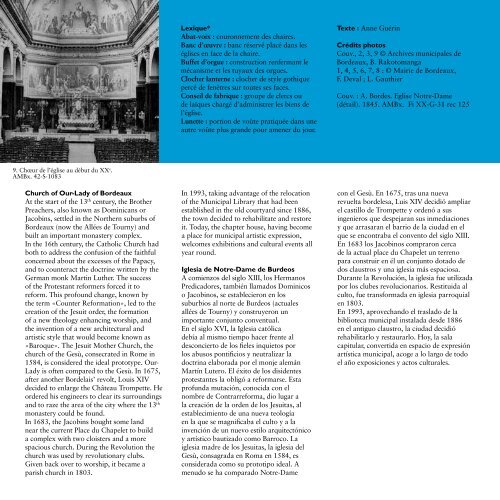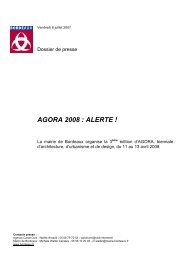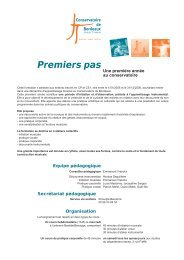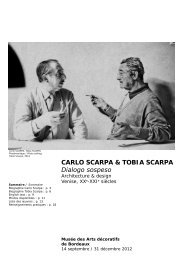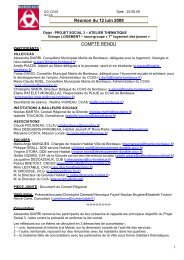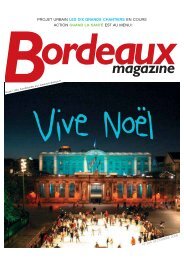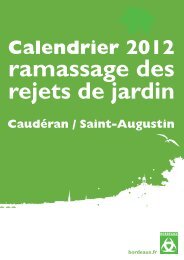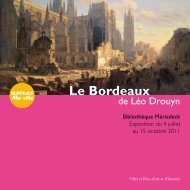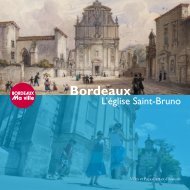L'église Notre-Dame - Bordeaux
L'église Notre-Dame - Bordeaux
L'église Notre-Dame - Bordeaux
Create successful ePaper yourself
Turn your PDF publications into a flip-book with our unique Google optimized e-Paper software.
Lexique*<br />
Abat-voix : couronnement des chaires.<br />
Banc d’œuvre : banc réservé placé dans les<br />
églises en face de la chaire.<br />
Buffet d’orgue : construction renfermant le<br />
mécanisme et les tuyaux des orgues.<br />
Clocher lanterne : clocher de style gothique<br />
percé de fenêtres sur toutes ses faces.<br />
Conseil de fabrique : groupe de clercs ou<br />
de laïques chargé d’administrer les biens de<br />
l’église.<br />
Lunette : portion de voûte pratiquée dans une<br />
autre voûte plus grande pour amener du jour.<br />
Texte : Anne Guérin<br />
Crédits photos<br />
Couv., 2, 3, 9 © Archives municipales de<br />
<strong>Bordeaux</strong>, B. Rakotomanga<br />
1, 4, 5, 6, 7, 8 : © Mairie de <strong>Bordeaux</strong>,<br />
F. Deval ; L. Gauthier<br />
Couv. : A. Bordes. Eglise <strong>Notre</strong>-<strong>Dame</strong><br />
(détail). 1845. AMBx. Fi XX-G-31 rec 125<br />
9. Chœur de l’église au début du XX e .<br />
AMBx. 42-S-1083<br />
Church of Our-Lady of <strong>Bordeaux</strong><br />
At the start of the 13 th century, the Brother<br />
Preachers, also known as Dominicans or<br />
Jacobins, settled in the Northern suburbs of<br />
<strong>Bordeaux</strong> (now the Allées de Tourny) and<br />
built an important monastery complex.<br />
In the 16th century, the Catholic Church had<br />
both to address the confusion of the faithful<br />
concerned about the excesses of the Papacy,<br />
and to counteract the doctrine written by the<br />
German monk Martin Luther. The success<br />
of the Protestant reformers forced it to<br />
reform. This profound change, known by<br />
the term «Counter Reformation», led to the<br />
creation of the Jesuit order, the formation<br />
of a new theology enhancing worship, and<br />
the invention of a new architectural and<br />
artistic style that would become known as<br />
«Baroque». The Jesuit Mother Church, the<br />
church of the Gesù, consecrated in Rome in<br />
1584, is considered the ideal prototype. Our-<br />
Lady is often compared to the Gesù. In 1675,<br />
after another Bordelais’ revolt, Louis XIV<br />
decided to enlarge the Château Trompette. He<br />
ordered his engineers to clear its surroundings<br />
and to raze the area of the city where the 13 th<br />
monastery could be found.<br />
In 1683, the Jacobins bought some land<br />
near the current Place du Chapelet to build<br />
a complex with two cloisters and a more<br />
spacious church. During the Revolution the<br />
church was used by revolutionary clubs.<br />
Given back over to worship, it became a<br />
parish church in 1803.<br />
In 1993, taking advantage of the relocation<br />
of the Municipal Library that had been<br />
established in the old courtyard since 1886,<br />
the town decided to rehabilitate and restore<br />
it. Today, the chapter house, having become<br />
a place for municipal artistic expression,<br />
welcomes exhibitions and cultural events all<br />
year round.<br />
Iglesia de <strong>Notre</strong>-<strong>Dame</strong> de Burdeos<br />
A comienzos del siglo XIII, los Hermanos<br />
Predicadores, también llamados Dominicos<br />
o Jacobinos, se establecieron en los<br />
suburbios al norte de Burdeos (actuales<br />
allées de Tourny) y construyeron un<br />
importante conjunto conventual.<br />
En el siglo XVI, la Iglesia católica<br />
debía al mismo tiempo hacer frente al<br />
desconcierto de los fieles inquietos por<br />
los abusos pontificios y neutralizar la<br />
doctrina elaborada por el monje alemán<br />
Martín Lutero. El éxito de los disidentes<br />
protestantes la obligó a reformarse. Esta<br />
profunda mutación, conocida con el<br />
nombre de Contrarreforma, dio lugar a<br />
la creación de la orden de los Jesuitas, al<br />
establecimiento de una nueva teología<br />
en la que se magnificaba el culto y a la<br />
invención de un nuevo estilo arquitectónico<br />
y artístico bautizado como Barroco. La<br />
iglesia madre de los Jesuitas, la iglesia del<br />
Gesù, consagrada en Roma en 1584, es<br />
considerada como su prototipo ideal. A<br />
menudo se ha comparado <strong>Notre</strong>-<strong>Dame</strong><br />
con el Gesù. En 1675, tras una nueva<br />
revuelta bordelesa, Luis XIV decidió ampliar<br />
el castillo de Trompette y ordenó a sus<br />
ingenieros que despejaran sus inmediaciones<br />
y que arrasaran el barrio de la ciudad en el<br />
que se encontraba el convento del siglo XIII.<br />
En 1683 los Jacobinos compraron cerca<br />
de la actual place du Chapelet un terreno<br />
para construir en él un conjunto dotado de<br />
dos claustros y una iglesia más espaciosa.<br />
Durante la Revolución, la iglesia fue utilizada<br />
por los clubes revolucionarios. Restituida al<br />
culto, fue transformada en iglesia parroquial<br />
en 1803.<br />
En 1993, aprovechando el traslado de la<br />
biblioteca municipal instalada desde 1886<br />
en el antiguo claustro, la ciudad decidió<br />
rehabilitarlo y restaurarlo. Hoy, la sala<br />
capitular, convertida en espacio de expresión<br />
artística municipal, acoge a lo largo de todo<br />
el año exposiciones y actos culturales.


